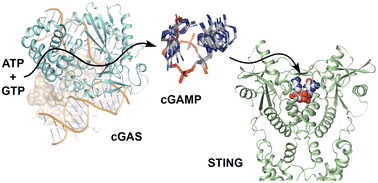The discovery of cGAMP in 2012 filled an important gap in our understanding of innate immune signaling. It has been known for over a century that DNA can induce immune responses, but the underlying mechanism was not clear. With the identification of STING as a key player in interferon induction, the DNA detector that activates STING was the last missing link in TBK1-IRF3 signaling. Somewhat unexpectedly, it turns out that nature relays the DNA danger signal through a small molecule. cGAMP is a cyclic dinucleotide produced from cyclodimerization of ATP and GTP upon detection of cytosolic DNA by cGAS, a previously uncharacterized protein, to promote the assembly of the STING signalosome. This article covers a personal account of the discovery of cGAMP, a short history of the relevant nucleotide chemistry, and a summary of the latest development in this field of research in chemistry. It is the author's hope that, with a historic perspective, the readers can better appreciate the synergy between chemistry and biology in drug development.
